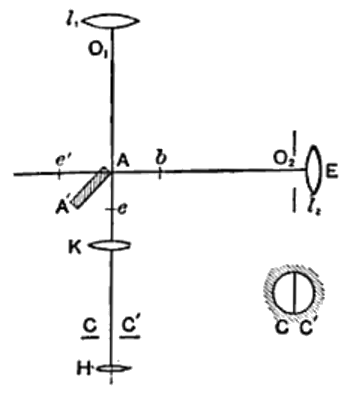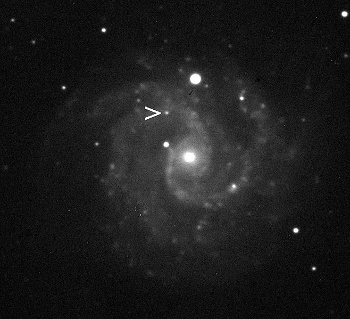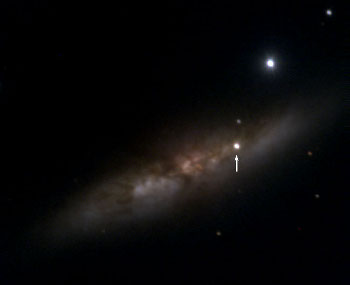Standard Candles
April 4, 2014
Science is performed with the
tools at hand. At one time,
voltage was measured with middling
accuracy using
gold leaf electroscopes, later replaced with
moving coil galvanometers. Today, most
laboratories have
digital voltmeters of high
sensitivity and
high resolution. In my
graduate student days, there were no
computers for
automated data acquisition. There was just me, staring at the needle of a voltmeter or
ammeter, recording data in my
laboratory notebook, or the occasional pasted snip from a
chart recorder.
Applied optics has been with us at least as long as
Archimedes reportedly used a
heat ray on
Roman ships during the
Siege of Syracuse (c. 214-212 BC). It's supposed that the "Archimedes heat ray" was formed by
focusing mirrors directing
sunlight to the easily
ignited tarred timbers.
Scientists can only measure things with respect to
standards. Some standards are physical objects, such as those maintained as the
international prototype kilogram and the
international prototype meter at the
International Bureau of Weights and Measures (Bureau international des poids et mesures) near
Paris. Although the
meter is now defined as a multiple of the
wavelength of an
energy level transition in
krypton-86, the prototype
kilogram is still an important standard.
Photometry and
radiometry are areas of
physics for which standardization has always proven difficult. The
candela is the
unit of
luminous intensity. One candela is roughly the luminous intensity of a
candle simply because a standard candle was used as a reference.
Candles, however, vary in their
light output, so the composition and structure of a standard candle is specified. The
wax is pure
spermaceti, a wax found in the head cavities of
sperm whales, and there are specifications for
flame height and burn rate, since these are factors in the candle's light output. The German Association of Gas and Water Industries adopted a different standard in 1868 for which the candle material is
paraffin wax.[1]
Photometry in the
nineteenth century was done by comparison of the light of such a candle to the light source under study. The figure shows one such device in which the light of the standard candle was compared by eye to other light sources on a split screen. The
human eye is good at seeing differences in light intensity this way, so the distance to the standard candle or the light source under study were changed to equalize the light intensity. Simple
mathematics gave you the source intensity in candelas.

A photometer invented by French physicist, Marie Alfred Cornu (1841-1902).
The distance to the standard candle (l) and light source (E) were varied to equalize light on both sides of the split screen (C-C').
(Fig. 26, page 59, of
Ref. 1.)[1)]
Astronomers can measure the
distances to nearby
stars using
parallax, whence the distance unit,
parsec, from "parallax
arcsecond." Present day
satellite measurements have allowed distance determination out to about a thousand
light years (9,460,730,472,580 km). This seems like a long distance, but our
Milky Way Galaxy is about 100,000 light-years in
diameter, so another measurement technique is required.
Although there are other methods, one straightforward technique is to measure the brightness of stars and compute distances according to the i
inverse-square law with reference to stars measured by the parallax method. Not all stars are the same, but we can group them according to their
spectral class to get good distance estimates. however, the nearby
Andromeda Galaxy is still 2.5 million light years away, which was too far for the
optical telescopes of the
last century to image their individual stars.
There are some stars,
type Ia supernovae, that are individually visible, even at
galactic distances. These
supernovae, which are exploding stars, will briefly outshine their host galaxy, and it's been found that the peak brightness of all type Ia supernovae is the same. It's thus possible to calculate their distance. These are among the better
"standard candles" of the universe.

X marks the spot. Well, part of an X.
Discovery image of supernova 2010dn in NGC3184.
NGC3184 is about 40 million light years distant.
(Image by Kevin Heider, via Wikimedia Commons.)
Every new supernova is an opportunity to refine the
statistics for this standard candle. Astronomers at the
University of California, Berkeley, and the Itagaki Astronomical Observatory (
Yamagata, Japan) have just
published their analysis of the recent supernova, SN 2014HJ, discovered in January, 2014.[2-4] This supernova is important, since it's the nearest known type Ia supernova since
SN 1986G, discovered on May 3, 1986, in the galaxy,
Centaurus A, just 15 million lightyears distant.
Supernova SN 2014HJ is located in the galaxy,
M82, also called NGC 3034 (or the "Cigar Galaxy"). This galaxy is 11.4 million light years distant. Although this supernova was discovered about seven days after its explosion,
prediscovery images were obtained by the
Katzman Automatic Imaging Telescope at
Lick Observatory, and by
Koichi Itagaki, a
Japanese amateur astronomer. These
data were sufficient to estimate the time of initial explosion as January 14, 2014, at about 18:00 UT, or 0.82 ± 0.21 days before the first possible detection.[2-3]
The data were unusual, since they showed a varying
power law in early-time light curves. Supernova SN 2013dy had the same, so now there are two examples of this effect, which is a faster brightening than other type-Ia supernovae.[2-3] The response is different from that of a third type-Ia supernova,
SN 2011fe, discovered three years ago.[4] Says study author and University of California, Berkeley, astronomer
Alexei Filippenko,
"Now, two of the three most recent and best-observed Type Ia supernovae are weird, giving us new clues to how stars explode... This may be teaching us something general about Type Ia supernovae that theorists need to understand. Maybe what we think of as 'normal' behavior for these supernovae is actually unusual, and this weird behavior is the new normal."[4]

Supernova SN2014HJ, located in M82, 11.4 million light years distant.
This is a composite of different images, with the supernova marked with an arrow.
(UC Berkeley image by W. Zheng and A. Filippenko.)
Such discoveries as this are only possible because of automated searches that scan selected patches of sky on a continual basis.[4] The Katzman Automatic Imaging Telescope, operated by
postdoctoral scholar,
WeiKang Zheng, takes images in five different spectral bands. In 2012, it captured images of supernova SN 2012cg just three minutes after its discovery.[4] Says Filippenko,
"Very, very early observations give us the most stringent constraints on what the star's behavior really is in the first stages of the explosion, rather than just relying on theoretical speculation or extrapolating back from observations at later times, which is like observing adolescents to understand early childhood."[4]
This research was funded by the
National Science Foundation and various private foundations.[4]
References:
- Adrien Palaz, George Washington Patterson and Merib Rowley Patterson, "A treatise on industrial photometry with special application to electric lighting," D. Van Nostrand company, 1896, 324 pages (Google Books).
- WeiKang Zheng, Isaac Shivvers, Alexei V. Filippenko, Koichi Itagaki, Kelsey I. Clubb, Ori D. Fox, Melissa L. Graham, Patrick L. Kelly and Jon C. Mauerhan, "Estimating the First-Light Time of the Type Ia Supernova 2014J in M82," The Astrophysical Journal Letters, vol. 783, no. 1, Document No. L24, doi:10.1088/2041-8205/783/1/L24.
- WeiKang Zheng, Isaac Shivvers, Alexei V. Filippenko, Koichi Itagaki, Kelsey I. Clubb, Ori D. Fox, Melissa L. Graham, Patrick L. Kelly and Jon C. Mauerhan, "Estimating the First-Light Time of the Type Ia Supernova 2014J in M82," arXiv Preprint Server, February 10, 2014.
- By Robert Sanders, "Closest, brightest supernova in decades is also a little weird," University of California, Berkeley, Press Release, February 27, 2014.
- Web Site of the Katzman Automatic Imaging Telescope at Lick Observatory.
Permanent Link to this article
Linked Keywords: Science; tool; voltage; accuracy and precision; gold leaf electroscope; moving coil galvanometer; laboratory; digital display device; voltmeter; sensitivity; resolution; postgraduate education; graduate student; computer; automated data acquisition; ammeter; laboratory notebook; chart recorder; applied physics; optics; Archimedes; heat ray; Roman Empire; ships; Siege of Syracuse (c. 214-212 BC); focus; mirror; sunlight; combustion; ignition; tar; lumber; timber; scientist; standard; international prototype kilogram; international prototype meter; International Bureau of Weights and Measures; Paris; meter; wavelength; energy level; krypton-86; kilogram; photometry; radiometry; physics; candela; unit; luminous intensity; candle; light; wax; spermaceti; sperm whale; flame; paraffin wax; 19th century; nineteenth century; human eye; mathematics; France; French; physicist; Marie Alfred Cornu (1841-1902); astronomer; distance; star; parallax; parsec; arcsecond; satellite; light year; Milky Way Galaxy; diameter; inverse-square law; stellar classification; spectral class; Andromeda Galaxy; optical telescope; 20th century; type Ia supernova; galactic; supernovae; cosmic distance ladder; "standard candles" of the universe; NGC3184; Kevin Heider; Wikimedia Commons; statistics; University of California, Berkeley; Yamagata, Japan; academic publishing; SN 1986G; Centaurus A; Messier 82; M82; prediscovery; Katzman Automatic Imaging Telescope; Lick Observatory; Koichi Itagaki; Japan; Japanese; amateur astronomy; amateur astronomer; data; power law; SN 2011fe; Alexei Filippenko; W. Zheng; postdoctoral research; postdoctoral scholar; WeiKang Zheng; National Science Foundation; Adrien Palaz, George Washington Patterson and Merib Rowley Patterson, "A treatise on industrial photometry with special application to electric lighting," D. Van Nostrand company, 1896, 324 pages.